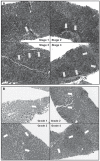Dialysis reduces portal pressure in patients with chronic hepatitis C
- PMID: 20653650
- PMCID: PMC3727277
- DOI: 10.1111/j.1525-1594.2009.00925.x
Dialysis reduces portal pressure in patients with chronic hepatitis C
Abstract
The purpose of this study was to characterize changes in hepatic venous pressures in patients with chronic hepatitis C. The histology and laboratory data from patients with chronic hepatitis C who underwent a transjugular liver biopsy (TJLB) and hepatic venous pressure gradient measurement were analyzed. Portal hypertension was defined as hepatic venous pressure gradient > or =6 mm Hg. A single pathologist masked to hepatic venous pressure gradient scored liver sections for inflammation and fibrosis. The patients with high-grade inflammation (relative risk [RR] 2.82, P = 0.027, multivariate analysis) and late-stage fibrosis (RR 2.81, P = 0.022) were more likely to have a hepatic venous pressure gradient > or =6 mm Hg, while the patients on dialysis (RR 0.32, P = 0.01) were less likely to have a hepatic venous pressure gradient > or =6 mm Hg. The patients on dialysis (n = 58) had an elevated serum blood urea nitrogen and creatinine when compared with those who were not (n = 75) (47.6 +/- 3.3 and 7.98 +/- 0.4 vs. 25.9 +/- 2.0 and 1.66 +/- 0.22 mg/dL, respectively; P < 0.001). While the hepatic venous pressure gradient increased with the rising levels of liver fibrosis in the latter group (P < 0.01), it did not change in the patients on dialysis (P = 0.41). The median hepatic venous pressure gradient was especially low in late-stage fibrosis patients on dialysis when compared with the latter group (5 vs. 10 mm Hg, P = 0.017). In patients on dialysis, serum transaminases were low across all levels of fibrosis. Twenty-three of the 92 patients with early fibrosis had a hepatic venous pressure gradient > or =6 mm Hg. In patients with chronic hepatitis C, concomitant TJLB and hepatic venous pressure gradient measurement identify those who have early fibrosis and portal hypertension. Long-term hemodialysis may reduce portal pressure in these patients.
Figures







Similar articles
-
Hepatic venous pressure gradient measurement in patients with liver cirrhosis: a correlation with disease severity and variceal bleeding.Medicina (Kaunas). 2009;45(1):8-13. Medicina (Kaunas). 2009. PMID: 19223700
-
Antiviral therapy decreases hepatic venous pressure gradient in patients with chronic hepatitis C and advanced fibrosis.Am J Gastroenterol. 2006 Oct;101(10):2269-74. doi: 10.1111/j.1572-0241.2006.00743.x. Am J Gastroenterol. 2006. PMID: 17032192 Clinical Trial.
-
Hepatic venous pressure gradient and transjugular liver biopsy to assess patients with kidney failure and chronic liver disease.Nefrologia. 2011;31(4):490-2. doi: 10.3265/Nefrologia.pre2011.May.10878. Nefrologia. 2011. PMID: 21738254 English, Spanish. No abstract available.
-
Assessment of the agreement between wedge hepatic vein pressure and portal vein pressure in cirrhotic patients.Dig Liver Dis. 2005 Aug;37(8):601-8. doi: 10.1016/j.dld.2005.02.009. Dig Liver Dis. 2005. PMID: 15908290 Review.
-
Diagnosing and monitoring cirrhosis: Liver biopsy, hepatic venous pressure gradient and elastography.Gastroenterol Hepatol. 2012 Aug-Sep;35(7):488-95. doi: 10.1016/j.gastrohep.2012.02.010. Epub 2012 May 3. Gastroenterol Hepatol. 2012. PMID: 22560536 Review.
Cited by
-
Ultrasound Pressure Estimation for Diagnosing Portal Hypertension in Patients Undergoing Dialysis for Chronic Kidney Disease.J Ultrasound Med. 2022 Sep;41(9):2181-2189. doi: 10.1002/jum.15897. Epub 2021 Dec 1. J Ultrasound Med. 2022. PMID: 34850412 Free PMC article. Clinical Trial.
-
Equal 3-Year Outcomes for Kidney Transplantation Alone in HCV-Positive Patients With Cirrhosis.Int Surg. 2015 Jan;100(1):142-54. doi: 10.9738/INTSURG-D-13-00231.1. Int Surg. 2015. PMID: 25594655 Free PMC article.
-
Splenic Arterial Pulsatility Index to Predict Hepatic Fibrosis in Hemodialysis Patients with Chronic Hepatitis C Virus Infection.J Clin Med. 2023 Mar 3;12(5):2020. doi: 10.3390/jcm12052020. J Clin Med. 2023. PMID: 36902807 Free PMC article.
-
Transient elastography to assess hepatic fibrosis in hemodialysis chronic hepatitis C patients.Clin J Am Soc Nephrol. 2011 May;6(5):1057-65. doi: 10.2215/CJN.04320510. Epub 2011 Mar 10. Clin J Am Soc Nephrol. 2011. PMID: 21393486 Free PMC article. Clinical Trial.
References
-
- Garcia-Tsao G. Current management of the complications of cirrhosis and portal hypertension: variceal hemorrhage, ascites, and spontaneous bacterial peritonitis. Gastroenterology. 2001;120:726–48. - PubMed
-
- Burroughs AK, McCormick PA. Natural history and prognosis of variceal bleeding. Baillieres Clin Gastroenterol. 1992;6:437–50. - PubMed
-
- Nguyen GC, Segev DL, Thuluvath PJ. Nationwide increase in hospitalizations and hepatitis C among inpatients with cirrhosis and sequelae of portal hypertension. Clin Gastroenterol Hepatol. 2007;5:1092–9. - PubMed
-
- Groszmann RJ, Wongcharatrawee S. The hepatic venous pressure gradient: anything worth doing should be done right. Hepatology. 2004;39:280–2. - PubMed
-
- Groszmann RJ. The hepatic venous pressure gradient: has the time arrived for its application in clinical practice? Hepatology. 1996;24:739–41. - PubMed
Publication types
MeSH terms
Grants and funding
LinkOut - more resources
Full Text Sources
Medical

